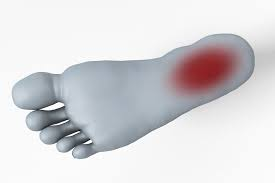
While the foot is in motion during running or walking, the plantar fascia, a thick elastic tissue that stretches from the heel to the base of the toes, works with the Achilles tendon to store and return energy. Because of this powerful attachment, the plantar fascia stabilises the inner forefoot as forces peak during push-off at the end of a stride. Unlike bone spurs and stress fractures of the heel, plantar fasciitis tends to produce pain during the push-off phase while running, and not during initial contact when the foot lands on the ground.
Recent research has shown it to be similar to a tendinopathy, where there is a degenerative process involved, including features of collagen breakdown, calcification, nerve and vascular ingrowth. This is why it can sometimes be referred to as plantar fasciopathy.
THE SYMPTOMS
- A sharp stabbing pain or deep ache in the arch of your foot or in the middle of the bottom of your heel.
- Stiffness or pain first thing in the morning (especially when you first get out of bed) that tends to lessen a bit with a few steps, but also tends to worsen as the day progresses and your body fatigues.
- Pain that worsens when climbing the stairs or standing on one’s toes.
- It is a notoriously nagging injury, and running through it, while possible, can delay healing.
Often once you have warmed up and started running the pain eases only to return towards the end of a long run or later that day. Take care, this can become a vicious cycle.
The Fix:
Plantar fasciitis is considered a self-limiting condition of variable duration. With treatment, symptoms usually improve over 3-6 months. However, patients performing prolonged standing and painful loading of the tissue may require longer, up to 9 or 12 months. Treatment includes mobilising tight structures and fascia and strengthening the foot muscles:












